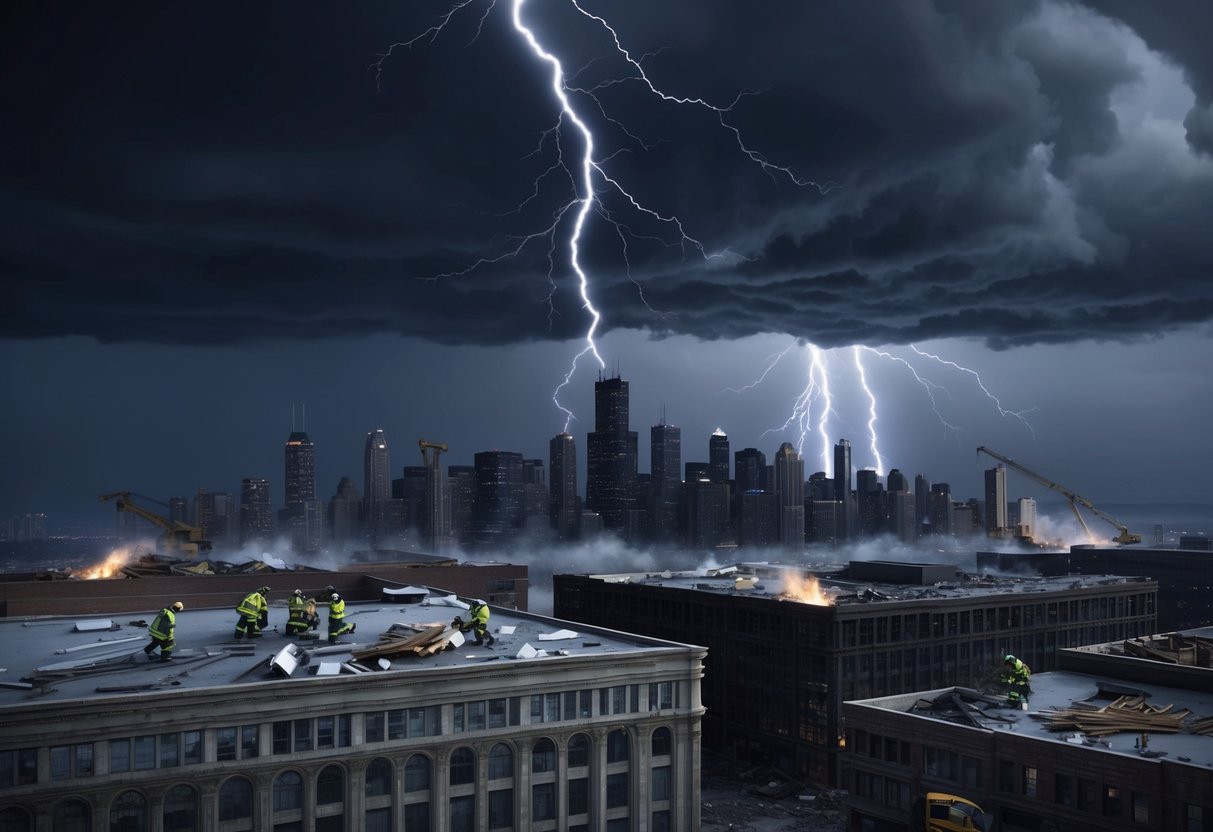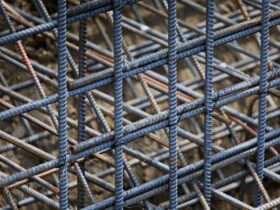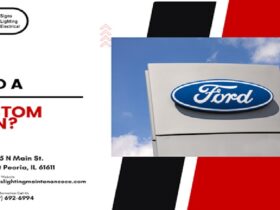Storms can wreak havoc on commercial roofs in Chicago. Strong winds, heavy rain, and hail often lead to damage that needs quick fixing. When left unaddressed, even small issues can turn into big, costly problems.
Fast roof repairs are key after a storm hits. Quick action helps prevent water damage, mold growth, and structural issues that can disrupt business operations. A prompt response also keeps repair costs down and extends the life of the roof.
Chicago building owners should know the signs of storm damage. These may include missing shingles, dents from hail, or water stains on ceilings. After a storm, it’s wise to call a pro for a thorough roof inspection. This helps catch hidden problems early on.
Chicago’s Weather Patterns and Impact on Roofing
Chicago faces frequent severe storms that can damage commercial roofs. These weather events require building owners to stay alert and maintain their roofs properly.
Frequency of Severe Storms in the Midwest
The Greater Chicago area experiences numerous storms throughout the year. Thunderstorms are common in spring and summer, often bringing heavy rain, hail, and strong winds.
Winter brings its own challenges with snowstorms and freezing temperatures. These conditions can cause ice dams and put extra weight on roofs.
The Midwest sees an average of 50 thunderstorm days per year. Chicago itself can expect 38 to 40 thunderstorms annually. Severe storms may include:
- Tornadoes
- Hailstorms
- High winds (up to 70 mph)
- Heavy rainfall
Implications for Roof Maintenance and Repairs
Chicago’s harsh weather makes regular roof maintenance crucial. Building owners need to prepare for storm damage repair throughout the year.
After storms, it’s important to check for:
- Loose or missing shingles
- Damaged flashing
- Clogged gutters
- Water leaks
Quick repairs prevent small issues from becoming major problems. Regular inspections help spot potential weaknesses before storms hit.
Roofing materials matter too. Some options stand up better to Chicago’s weather. For example, metal roofs resist wind damage well. Proper installation is key for any roofing type to withstand local conditions.
Commercial Roofing Systems and Common Issues
Commercial buildings in Chicago use different roofing systems to protect against harsh weather. These systems can have weak spots that storms may damage. Fast repairs are key to avoiding bigger problems.
Types of Roofing Systems in Chicago
Chicago commercial buildings often use flat or low-slope roofs. Common types include:
- Built-up roofing (BUR): Layers of bitumen and reinforcing fabric
- Modified bitumen: Rubber-like sheets with added durability
- EPDM: Synthetic rubber membrane, known for flexibility
- TPO: White reflective material, energy-efficient option
- Metal roofing: Long-lasting, can handle heavy snow loads
Each system has pros and cons. BUR offers strong protection but is heavy. EPDM resists UV rays well. TPO reflects heat, cutting cooling costs.
Identifying Vulnerabilities in Commercial Roofs
Leaks and moisture are top issues for commercial roofs. Signs of trouble include:
• Water stains on ceilings or walls • Bubbles or blisters in roofing material • Visible cracks or gaps in seams
Poor ventilation can trap heat and moisture, leading to mold and weakening the roof structure. Flashing around vents and edges often fails first in storms.
Regular inspections help spot these issues early. Look for loose materials, ponding water, or damaged drainage systems.
Prioritizing Fast Repairs Post-Storm
After a storm, quick action prevents further damage. Steps to take:
- Safety check: Ensure the building is safe to enter
- Document damage: Take photos for insurance claims
- Temporary fixes: Cover leaks with tarps if safe to do so
- Professional assessment: Get an expert to check the full extent of damage
Commercial roof repairs might include patching holes, replacing damaged sections, or fixing flashing. Some repairs can’t wait. Leaks can quickly lead to interior damage and mold growth.
Prioritize repairs that stop water entry first. Then address structural issues. Fast action saves money and protects your building in the long run.
The Process of Commercial Roof Repairs
Commercial roof repairs after a storm require careful planning and skilled execution. Trained technicians assess damage, implement targeted fixes, and ensure long-lasting protection.
Assessment of Storm Damage
Commercial roof technicians start by thoroughly inspecting the roof. They look for visible signs of damage like tears, punctures, or displaced materials. The team checks flashing, seams, and drainage systems.
High-tech tools help spot hidden issues. Infrared cameras detect moisture trapped under the surface. Drones capture aerial images of hard-to-reach areas.
Technicians document all findings with photos and detailed reports. This helps building owners understand the full scope of repairs needed.
Efficient Strategies for Roof Repair Services
Roof repair services use targeted approaches to fix storm damage quickly. For minor issues, patch repairs may suffice. Larger problems might need a partial roof replacement.
Technicians choose materials compatible with the existing roof system. They may use specialized adhesives, sealants, or membranes designed for commercial roofs.
Skilled teams work efficiently to minimize business disruption. They often section off repair areas to allow partial building use during fixes.
Safety is key. Workers use proper fall protection and follow strict protocols when handling tools and materials on elevated surfaces.
Ensuring Waterproofing and Durability
Waterproofing is crucial for long-term roof protection. Technicians apply high-quality sealants to repaired areas. They ensure proper overlap of materials to prevent future leaks.
Drainage systems get special attention. Workers clear debris and fix any damaged gutters or downspouts. Proper water flow helps prevent ponding and future damage.
For added durability, some repairs include reinforced coating systems. These create an extra barrier against harsh weather.
Technicians also address underlying issues that may have worsened storm damage. This might include improving ventilation or adding insulation to prevent ice dams.
Preventative Measures and Long-Term Roof Maintenance
Regular upkeep and proactive strategies can significantly extend the life of commercial roofs in Chicago. Proper maintenance helps prevent costly repairs and ensures roofs can withstand harsh weather conditions.
The Importance of Regular Inspections
Regular roof inspections are crucial for identifying potential issues before they become major problems. Professionals should check for signs of wear, damage, or leaks at least twice a year.
These inspections often include:
- Examining flashing and seals
- Checking drainage systems
- Looking for cracks or blisters in the roofing material
Catching small issues early can prevent water damage and structural problems. It also helps maintain the roof’s warranty and can save businesses money in the long run.
Snow Removal and Its Role in Roof Longevity
In Chicago’s harsh winters, snow removal is essential for roof maintenance. Heavy snow accumulation can stress the roof structure and lead to collapse.
Key points for snow removal:
- Use proper tools to avoid damaging the roof surface
- Remove snow in layers to prevent overloading one area
- Clear ice dams to prevent water backup and leaks
Regular snow removal helps prevent costly repairs and extends the roof’s lifespan. It’s best to hire professionals who understand safe removal techniques for commercial roofs.
Creating a Maintenance Plan for Commercial Roofs
A comprehensive maintenance plan is vital for long-term roof care. This plan should outline regular tasks and set a schedule for professional inspections.
Elements of a good maintenance plan:
- Seasonal cleaning of gutters and drains
- Trimming nearby trees to prevent debris accumulation
- Scheduling bi-annual professional inspections
- Prompt repairs of any identified issues
Implementing a roof maintenance program can nearly double a roof’s lifespan. It helps businesses avoid unexpected expenses and ensures the roof performs optimally throughout its life.
Additional Considerations in Roof Repair
Roof repairs involve more than just fixing immediate damage. Building owners must weigh several factors to ensure long-term protection and value for their property.
When to Opt for Roof Replacement Over Repair
Sometimes, roof replacement is a better choice than repairs. Age is a key factor. If a roof is nearing the end of its expected lifespan, replacement may be more cost-effective.
Frequent repairs can signal it’s time for a new roof. When repair costs add up to more than 30% of replacement costs, building owners should consider a full replacement.
Extensive damage covering a large area of the roof often makes replacement the smarter option. This ensures uniform protection and can improve energy efficiency.
The Role of Siding in Protecting Commercial Buildings
Siding works with the roof to shield a building from the elements. Properly installed siding prevents water intrusion and helps regulate indoor temperatures.
Commercial buildings benefit from durable siding materials like metal or fiber cement. These materials resist damage from wind, rain, and temperature changes.
Regular siding inspections are crucial. Damaged siding can let moisture into walls, leading to structural issues. Prompt repairs or replacement of siding protect the building’s integrity. This underscores the benefits of working with a roofing company like Huuso Exteriors which provides expertise in roofing and siding.
Differences Between Residential and Commercial Roofing Projects
Commercial roofs often cover larger areas than residential roofs. This means more materials and labor are needed for repairs or replacements.
Commercial roofing typically uses different materials than residential projects. Flat or low-slope roofs are common in commercial buildings, requiring specialized membranes or built-up roofing systems.
Safety regulations are stricter for commercial roofing projects. Workers need proper training and equipment to navigate large, often high roofs safely.
Commercial roof repairs may need to happen while the building is in use. This requires careful planning to minimize disruption to business operations.










